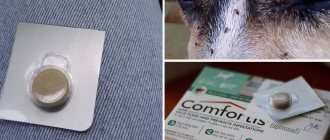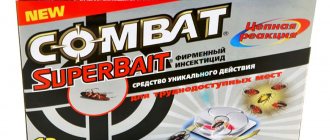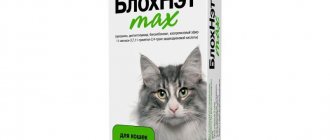Most of the territory of our country is a habitat for all kinds of ticks. But if it is generally not difficult for a person to protect himself from attacks by parasites - just choose the right clothes or take precautions - then your cat has much less such opportunities, especially considering the small size of our pets. And danger awaits them literally at every step: in the garden, in the vegetable garden, or even just on a city street. Today we will talk about how to protect your cat from ticks.
Pills
One of the relatively new methods of protection, which is just beginning to be actively used. In general, oral anti-tick medications were not developed for cats, but for small breed dogs. The action of the products is based on the fact that a toxic substance that kills the tick when sucked circulates in the animal’s blood (you must admit, this is far from the safest option for a cat).
Be sure to consult your doctor before using such medications. Although they have a positive aspect - when used internally, they do not pose a threat to small children or other pets.
Anti-tick drops
Every loving owner will carefully select a drug for his pet. There are drops on sale that are used only for adult cats, and others for kittens. For pregnant women and patients, medications have been developed with a softening effect.
Tick drops for cats are a liquid solution that fights pests. At the same time, it is low-toxic for the cat itself. But if a large amount of the drug enters the animal’s body, then poisoning is likely. Therefore, manufacturers recommend using this product on inaccessible places for licking.
A wide range of drugs allows you to choose the right product for any age, as well as for sick cats and pregnant cats. It is also worth considering individual intolerance. Knowing all these exceptions, when choosing, the question will not arise which anti-tick drops for cats are better.
Quite effective substances:
- Permethrin - has a way to instantly distribute throughout the pet's body, providing effective protection. If it penetrates the gastrointestinal tract of an animal, the product is instantly broken down without causing harm to health.
- Pyriproxyfen was previously used in animal collars as a filler against various parasites. Today it is directly used in the production of drops against ticks.
- Fipronil is the most modern development, which is safer for animals when compared with other means.
- Ivermectin is a universal remedy that can successfully fight a wide range of parasites.
- Biafar. Quite a popular remedy, suitable for both kittens and adult animals, in addition, it can also be used for weakened organisms. The product is not dangerous for animals, even if it enters the body in small quantities. Protects for a month.
- Leopard. May protect against ticks and fleas. Among Russian-made drugs, this particular product is more in demand. Compared with foreign manufacturers, the price is lower, but the efficiency is the same. It has a paralytic effect, which allows for the rapid death of the parasite.
- Frontline. Anti-parasite drops containing fipronil, which allows you to reliably fight ticks and fleas. A special feature of this medicine is that it reliably fights ear mites. Can be used for kittens from two months. Protects cats from ticks for three weeks.
- Hartz. A radical remedy that can destroy ticks within 24 hours from the moment of treatment. Use is only possible for adult and completely healthy cats. Apply to the line of the spine.
- Rolf Club. An effective drug that can neutralize ticks even before the bite occurs. Protects cats from ticks for a month.
When any of these substances enters the animal’s body, it is evenly distributed over the skin, enveloping the fur and, after some time, begins to evaporate. Vapors begin to actively penetrate the body of ticks, which leads to a decrease in their activity. When bitten, the drug immediately paralyzes the nervous system of the tick, which leads to instant death.
Drops on the withers
These substances are applied directly to the surface of your pet's skin, spreading the fur apart. It is noteworthy that the active components of such drugs do not enter the animal’s bloodstream, therefore, they do not have a strong toxic effect on the body. But the difficulty lies in the fact that the cat is a very flexible animal, therefore, when applying the product, choose places so that the pet cannot reach and inadvertently lick off particles of the drug. The validity period of the drops may vary, so read the instructions carefully and do not miss the time for the next treatment.
Fleas: know the enemy by sight!
Science knows about 2086 species of fleas, which are grouped into 18 families. In domestic pets, the most common types are feline and canine. In addition to cats and dogs, parasites attack large livestock, rodents and some species of birds. The most attractive animals for bloodsuckers are those with thick fur, where they hide and produce offspring.
The flea belongs to the order of wingless blood-sucking insects, since they lost their wings during the process of evolution. Scientists classify them as ectoparasites, as they live on the surface of the body and external organs. All insects have a similar structure. They have a laterally compressed, narrow, smooth body 0.75-5 mm long. There are spines on the legs, thanks to which the parasite is held on to the host. It moves by jumping with the help of strong developed limbs, with which it grabs the animal and moves along the fur. The flea's mouth is of the piercing-sucking type.
Life cycle and season of attack of an ectoparasite
The life cycle lasts 2-3 months, during which time the insect undergoes complete transformation. When it lands on a cat or dog, the female lays eggs, from which larvae hatch after 2 weeks. They grow actively, experience 3 molts and pupate. The emergence of fleas from the cocoon is associated with a certain time of year. Most often this is summer, but it happens that the flea attacks in winter, since it lives in bird nests or rodent burrows. Once on the victim, the parasite bites through the skin and attaches itself for 1 minute, causing incredible discomfort to the pet.
What danger do fleas pose?
Bloodsucker bites are painful and cause itching and skin irritation. This condition causes stress, lethargy, and loss of appetite in a cat or dog. The animal becomes nervous, constantly itches and bites its fur, and flea dermatitis appears. In addition to skin problems, fleas are carriers of pathogenic organisms, including:
- bacteria – salmonella, plague bacilli;
- viruses – hepatitis, encephalitis;
- helminths – tapeworms, trypanosoma.
Diseases pose a threat to the health and life of the animal. Although the flea itself does not live on a person, it can bite him and infect him with dangerous infections.
How to protect your pet - choosing protective equipment
Specialty stores provide a large selection of different products. These are collars, drops on the withers, tablets. All of them are impregnated with special agents that are destructive to bloodsuckers - insecticides. They provide comprehensive protection, helping in the fight against fleas and ticks.
Powder
They can be applied both to the animal's skin and in those areas of your yard where the animal spends the most time. The product perfectly fights parasites, but due to its high activity, it can pose a certain danger to the health of your pet - cause irritation of the respiratory tract and mucous membranes. To prevent this, apply the powder to the cat in small portions, thoroughly rubbing it into the skin.
When treating your cat, make sure that the product is as far away from your face as possible. And this method can confidently be classified as risky, since the animal can easily lick the drug and get poisoned.
Sprays
The spray can effectively kill parasites, which can effectively protect your cat. Anti-tick product for cats can be used together with shampoo. This aerosol will be especially useful if the cat spends more time outside.
When applying this product to your cat, be extremely careful not to get it in the eyes. You should also take care of yourself, otherwise you may get seriously poisoned.
Effective means:
- Frontline. The effect lasts about one month. Treat the animal at a distance of 10 to 20 centimeters, then rub it gently into the fur. Can be used for all types of cats. The downside of the drug is its high price.
- Bolfo, developed by Bayer. The cat must be treated at a distance of thirty centimeters, preferably against the fur. Within twenty minutes, you should try to limit the animal’s desire to lick the drug by wearing a muzzle or collar. It should be used with caution in the eye area, trying to avoid contact. Do not use on animals under six weeks of age. It is advisable to carry out the procedure outdoors or in a well-ventilated area. The downside of this product is the presence of a specific smell.
Collars for cats
Despite their high popularity, such collars offer little protection against tick attacks for cats. The fact is that the effect of the product spreads mainly to the head and neck of the animal, leaving the pelvis and abdomen practically unprotected (and everyone knows that it is the stomach, armpits and groin area that are most often attacked by ticks). This situation is provoked by the fact that collar manufacturers, in order not to harm the pet, impregnate it with a weak solution of the active substance. If you still decide to use it, buy a collar specifically for cats, and under no circumstances for dogs!
What is better against ticks for cats?
When the owner is faced with a choice as to what is best for cats against ticks, they should follow simple rules:
- First, you should take care of how the drug will affect the cat itself, what harm it can cause to the animal.
- Next, decide for what purpose the drug is used, for treatment or prophylactic purposes.
- Identify the characteristics of a pet. How much sensitivity to drugs is increased, whether there is a personal intolerance to any component, it is also worth taking into account the age of the cat. For example, for white cats that often take part in specialized exhibitions, it is not advisable to use drops. Otherwise, they can contribute to a change in color, making the color sloppy and dirty yellow.
- The physiological state of the animal should also be taken into account. For example, there are products that should not be used on pregnant cats, small kittens, or old cats. In addition, there are restrictions on cats that are post-surgery or are simply stressed.
Before purchasing the drug, you need to consult a specialist. But if there is no such person nearby, then you can study the instructions for the drug. It is important to take into account the duration of action of the product.
A cat that stays indoors all the time is less susceptible to tick attacks. But if there is also a dog living in the apartment, then she runs the risk of catching it. Therefore, it is worthwhile to control the animals after a walk.
Many different medications have been developed to protect pets. Spray, collars, shampoos, tablets, drops - these products last a long time. Each owner himself decides what to choose for his pet, according to the individual characteristics of the cat.
The main thing when choosing a drug is to read the instructions. The drug must not contain permethrin. It is very dangerous for cats. Instead, pyrethrin is allowed in the composition.
Checking the cat after a walk
Every time your cat returns home from the street, take the time to carefully examine her for the presence of parasites: thoroughly comb the animal’s fur with a thick comb, inspect the ear areas, paw pads, stomach, groin and armpits. Sometimes it is possible to find a bloodsucker that has not yet started the “meal” - in such cases the insect is immediately removed and burned. If the tick has already attached itself, remove it as soon as possible, thereby minimizing the risk of infection.
Of course, those cat lovers whose pets live inside the house and never go outside are least concerned about the problem of ticks. But this is not always possible, so if your four-legged friend loves long walks, do not limit his desires: just provide him with the most effective protection, and not a single tick will pose a danger to him! After all, our love and care can create real miracles. Health to you and your cats.
Safe use
You should work with tick drops with extreme caution and avoid getting them on your mucous membranes. If this does happen, the affected area must be urgently rinsed several times with water.
Some animals may have an individual intolerance to one of the components of the drug, signs of which usually appear during the first two days after use. And if you notice that your pet is behaving somewhat strangely, then it is advisable to seek help from a specialist.
As for licking droplets and the harm from them, they pose a serious threat to health only in high concentrations. This happens when a mother cat has washed her kittens that you have recently treated for ticks. There are already possible negative consequences that will require the intervention of a veterinarian. And to prevent such situations, it is recommended to treat babies only after they have been weaned from their mother.
On a note! And don’t forget that both kittens and adult cats can lick drops from each other’s bodies during play. For the former, this is fraught with serious problems, even death, for the latter – poisoning. Therefore, before you start anti-tick treatment, think about how you can isolate animals from each other!
Intoxication in an adult healthy animal manifests itself in the form of vomiting. Allergies in such animals are extremely rare, but it is still quite possible. As it develops, hair loss, severe itching, and dermatitis may occur.











